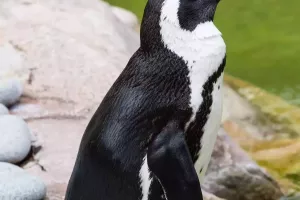Penguin's Big Family
When it comes to penguins, two colors come to mind in most people's minds, black and white. The belly is white, the back and front fins are black, isn't it a penguin? But if you look closely, you will find that there are many kinds of penguins, and the colors of their feathers are not only black and white.
Galapagos Penguins
The Galapagos penguin is only 50 centimeters tall when standing upright, with fins about 10 centimeters long and weighing 2 to 2.5 kilograms. The back is black and the belly is white with some spots formed by black feathers. Galapagos penguins live in the equatorial region, and the temperature in their habitat is much lower than other areas near the equator due to the influence of the Peruvian cold current, but keeping cool is still a headache for Galapagos penguins, so they Stay in water often.
Yellow-eyed penguin
The yellow-eyed penguin is related to the Magellanic penguin, but the yellow-eyed penguin is distinguished by its yellow eye feathers, from which it gets its name. Most of them live on islands near New Zealand.
Macaroni Penguin
Macaroni penguins are one of six crested penguins and can be found from the sub-Antarctic to the Antarctic Peninsula, with about 18 million surviving today. Macaroni penguins are the most numerous penguin species in the world.
Emperor penguins
Emperor Penguins Emperor penguins are the tallest of all penguin species at 4 feet tall. Antarctica's emperor penguins hunt fish, krill and crustaceans by diving, and they can dive down to 1,755 feet for up to 18 minutes. They are tall and have gorgeous neck patterns, and they are outstanding in appearance and temperament.
King penguin
King penguins are the second largest penguin species and can grow up to 3 feet tall. This penguin lives in Antarctica and is well adapted to extreme living conditions. Like most penguins, king penguins are able to drink salt water because their eye glands filter out excess salt. Although emperor penguins and king penguins are close relatives, their habitats are very different. While emperor penguins breed on the Antarctic ice sheet, king penguins live on the milder Antarctic islands.
Magellanic Penguin
They have a black stripe that resembles an inverted horseshoe on their white front belly, so they are classified as "ring penguins". They are not seen in Antarctica, and Magellanic penguins are mainly distributed in southern South America.
Little Penguin
Little penguins are the smallest penguin species, growing to an average of 13 inches in length and can be found off the coast of southern Australia and New Zealand. The wild population of this penguin is about 350,000 to 600,000. Although it is not an endangered species, local people still spare no effort to protect these penguins from extinction.







